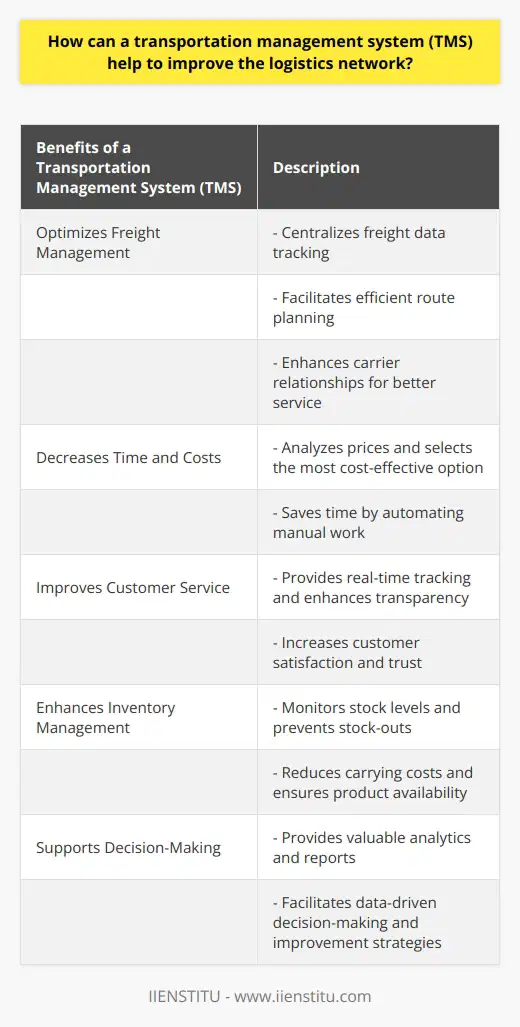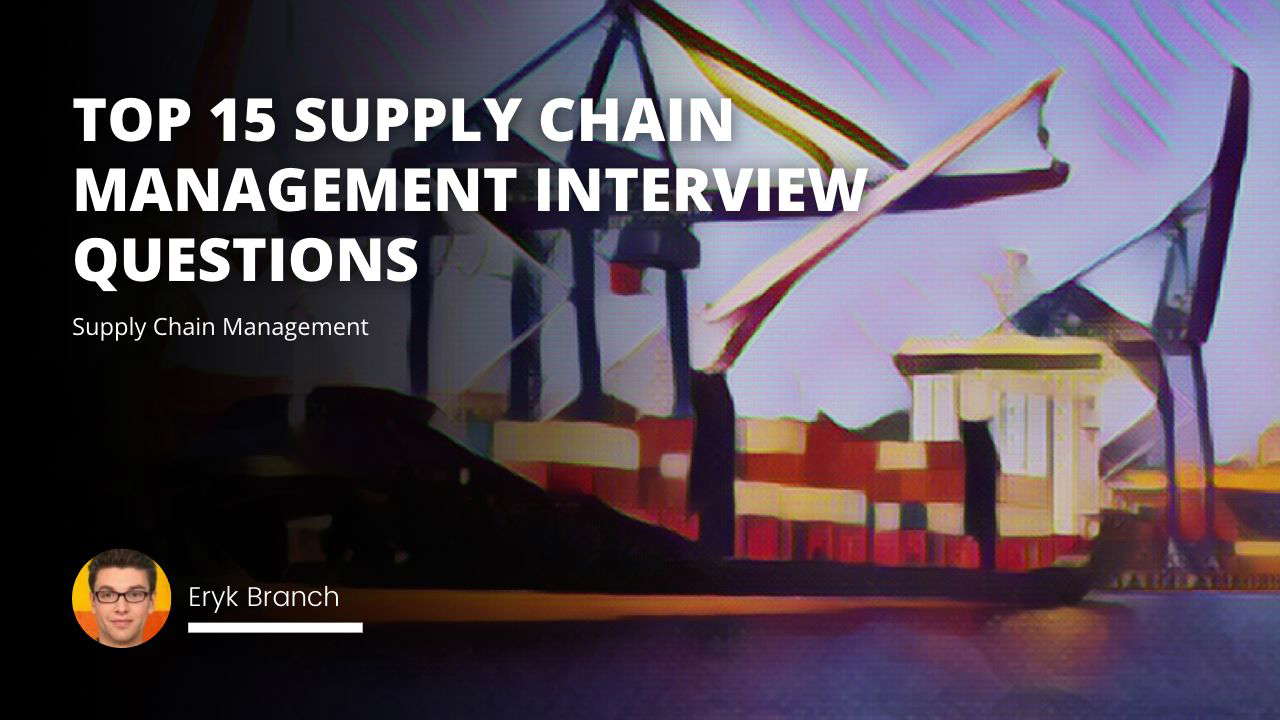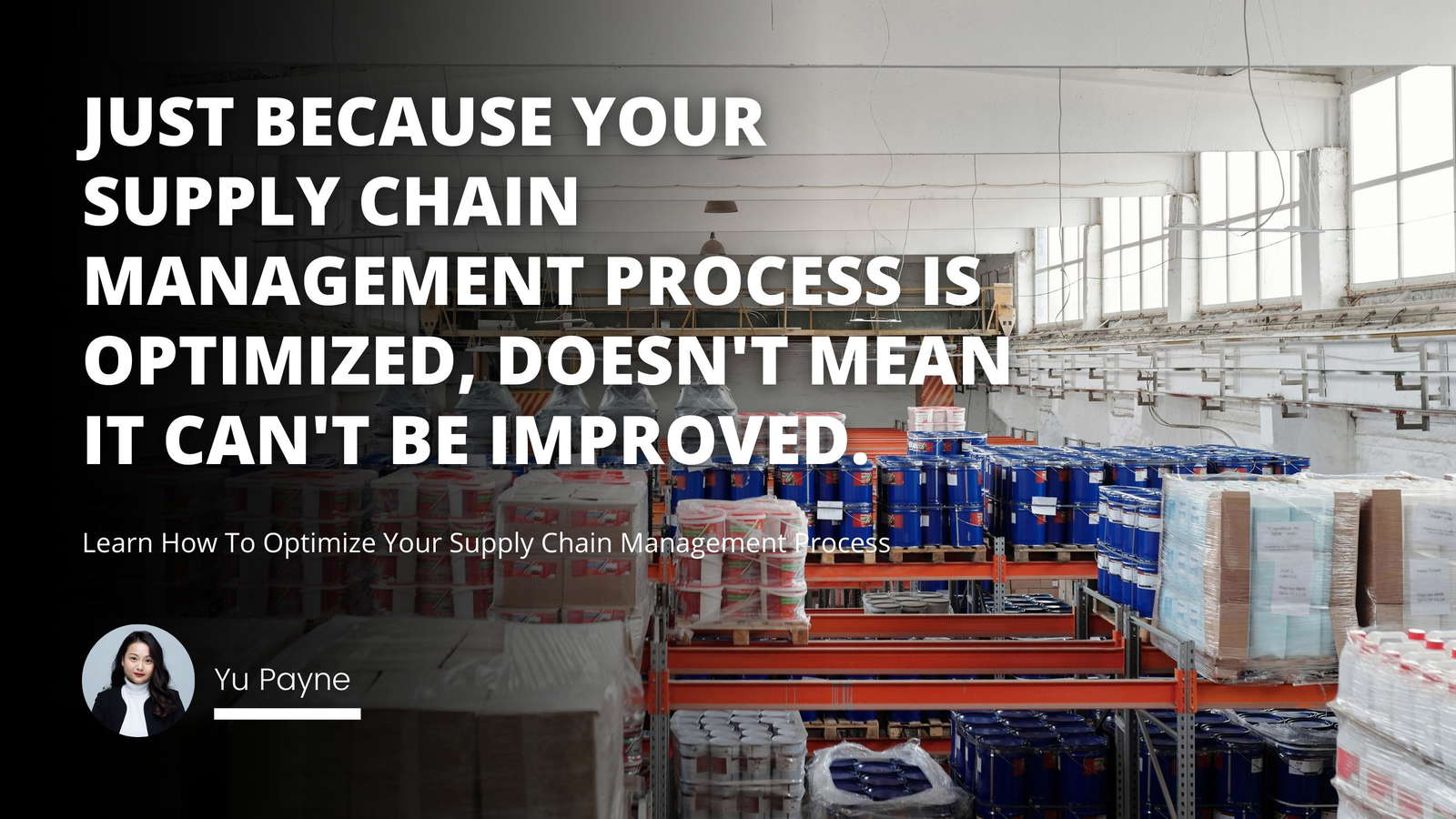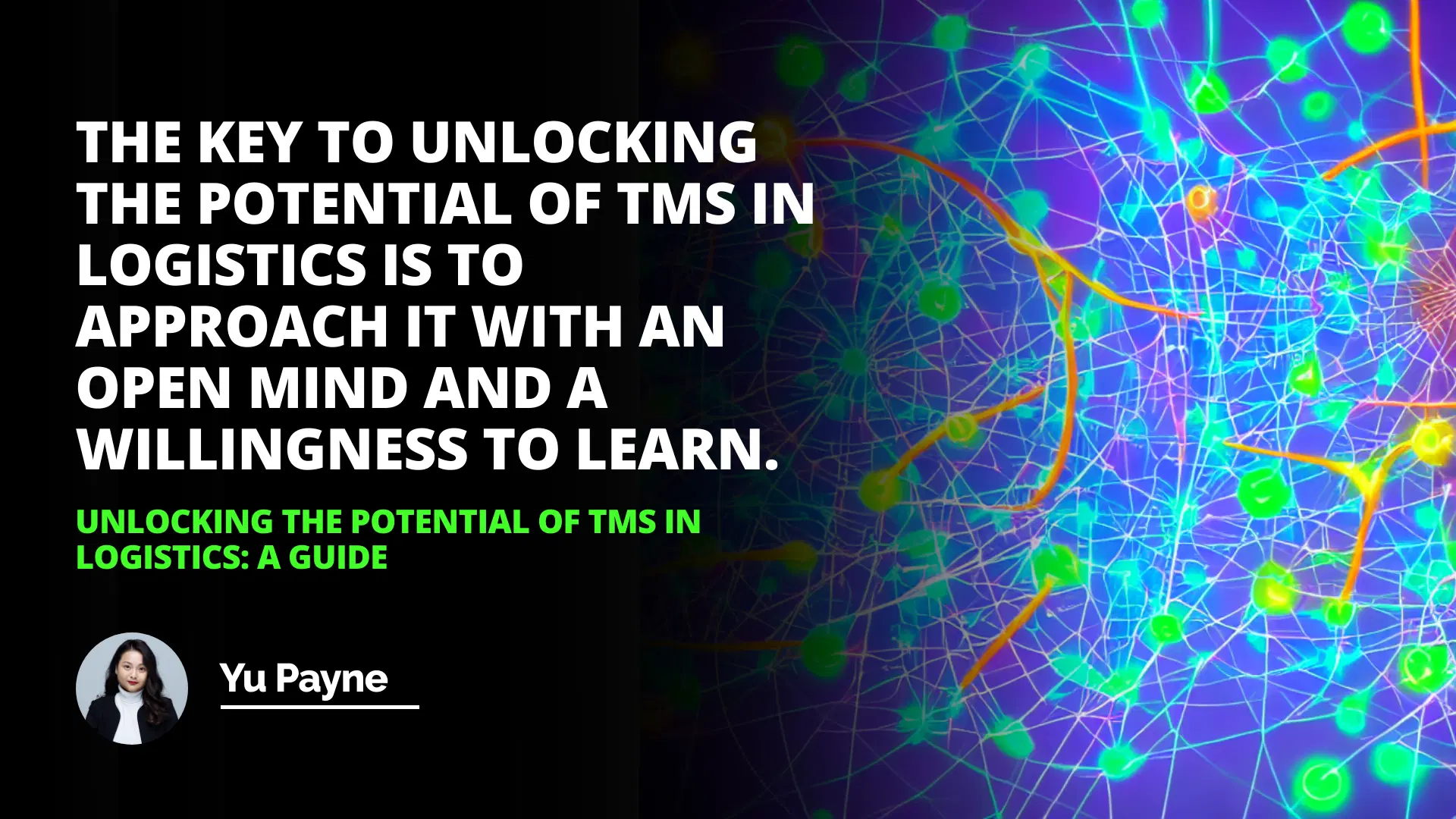
Introduction to Transportation Management Systems
Benefits of Implementing a TMS
Challenges of Using a TMS
Best Practices for Utilizing TMS
The Future of TMS in Logistics Management
Related Course: Logistics Course
The global supply chain landscape is constantly changing, and companies must find new ways to streamline their logistics operations and reduce costs. A Transportation Management System (TMS) is an effective tool that enables companies to manage better and optimize their transportation and logistics operations.
TMS solutions provide comprehensive data analytics, route optimization capabilities, improved shipment visibility, and enhanced customer service. By leveraging the power of TMS, companies can unlock the potential of their logistics operations to create a more efficient and cost-effective supply chain.
Benefits of Implementing a TMS
The benefits of implementing a TMS are numerous. TMS solutions allow companies to manage their transportation and logistics operations better, reduce costs, and improve customer service. By leveraging TMS, companies can gain a comprehensive view of their supply chain, enabling them to understand their processes better and identify areas of inefficiency.
TMS solutions also provide companies with route optimization and shipment visibility capabilities, allowing them to manage their fleets and shipments better. Furthermore, TMS solutions allow companies to react quickly to changes in the supply chain, allowing them to respond quickly to customer demands and reduce delivery times.
Challenges of Using a TMS
Although TMS solutions can provide companies with numerous benefits, some challenges are associated with using them. One of the biggest challenges is the cost associated with implementing and maintaining a TMS. Companies must consider the costs of purchasing and implementing the software, as well as the cost of training employees and maintaining the system.
Additionally, companies must ensure their TMS is compatible with their existing systems, as integration can be difficult and time-consuming.
Best Practices for Utilizing TMS
In order to ensure that TMS solutions are implemented and used effectively, companies must follow best practices for utilizing them. Companies should determine their specific needs and objectives and select a TMS tailored to their requirements. They should also ensure their existing systems are compatible with their chosen TMS.
Companies should also allocate resources to training their employees to use the TMS, which is critical to ensuring its successful implementation. Additionally, companies should ensure that their TMS is regularly updated to keep up with the latest technology and trends.
The Future of TMS in Logistics Management
As the global supply chain continues to evolve and become increasingly complex, TMS solutions are becoming increasingly important tools for logistics management. TMS solutions are constantly being improved and updated, and companies continue leveraging them to optimize their transportation and logistics operations.
As TMS solutions become more sophisticated, companies can better manage their operations and reduce costs. Additionally, as TMS solutions continue to evolve, companies can leverage the power of predictive analytics to make better decisions and gain a competitive edge in the global market.
Conclusion: Transportation Management Systems are powerful tools that enable companies to manage better and optimize their transportation and logistics operations. TMS solutions provide companies with numerous benefits, including comprehensive data analytics, route optimization capabilities, improved shipment visibility, and enhanced customer service. However, companies must select the right TMS for their needs and allocate resources to train their employees to use it. As TMS solutions continue to evolve, they will become increasingly important tools for logistics management and allow companies to gain a competitive edge in the global market.
The key to unlocking the potential of TMS in logistics is to approach it with an open mind and a willingness to learn.
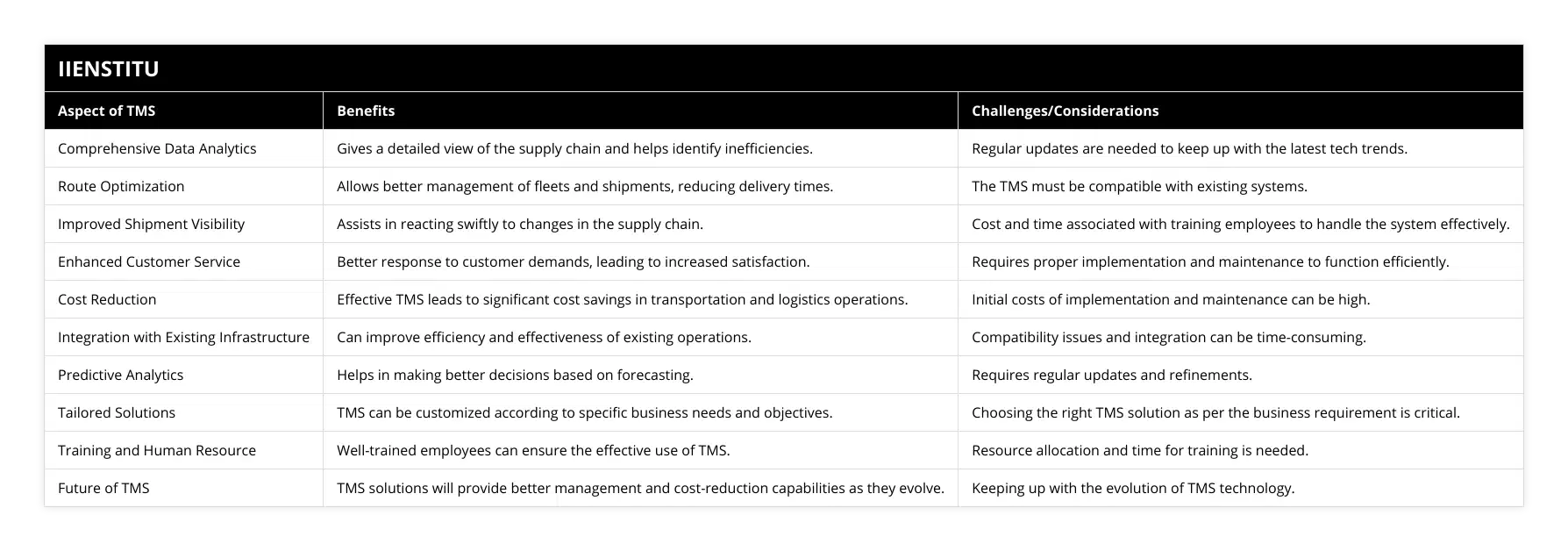
The text delves into the various aspects of Transportation Management Systems (TMS), highlighting their relevance in optimizing logistics operations. TMS provides comprehensive data analytics, enhanced customer service, route optimization capabilities, and improved shipment visibility. However, it also brings challenges including the cost of implementation and compatibility with existing systems. Best practices for TMS utilization and dedicated employee training can mitigate these issues. As TMS continues to evolve, it will become even more crucial in global logistics management. Interesting enough, the potential of TMS can be fully unlocked with an open mind, willingness to learn and possibly taking up a supply chain certification online to delve deeper into the complexities of the system.
Frequently Asked Questions
What are the benefits of implementing a TMS?
Implementing a Transportation Management System (TMS) has become increasingly popular among organizations and businesses in recent years. TMS is software that helps manage freight transportation logistics, including shipping costs, reducing lead times, and creating an efficient and reliable supply chain. The benefits of utilizing a TMS are numerous, making them attractive solutions for businesses looking to streamline their operations.
First and foremost, implementing a TMS allows for greater visibility into freight transportation processes. A TMS provides real-time updates on the status of shipments and offers various reporting capabilities that can help organizations make informed decisions about their operations. This improved visibility leads to higher accuracy in freight management, improved customer service, and increased cost savings due to fewer errors in shipping rates or routing decisions. Additionally, a TMS offers access to detailed analytics, which can be used to identify improvement areas to increase efficiency within the supply chain.
Furthermore, implementing a TMS allows organizations to leverage technology more effectively when managing their transportation processes. For example, a quality TMS will offer features such as route optimization software to help companies reduce operational costs by finding the most cost-effective shipping routes available at any given time. In addition, many modern systems integrate with other essential software solutions like ERP systems or CRM software, further enhancing an organization’s ability to manage its logistics efficiently.
Finally, using a TMS can help organizations increase compliance with legal requirements related to freight transportation, such as customs regulations or environmental laws, since these systems are designed with these regulations in mind from the start. By providing access to real-time tracking data and automated document proofs of delivery (POD), businesses utilizing a quality TMS can save time by quickly producing accurate documents required for regulatory compliance purposes when needed.
In conclusion, there are numerous benefits associated with implementing a Transportation Management System into an organization’s operations, including increased visibility into shipping processes, leveraging technology more effectively through route optimization software or integration with other solutions like ERP systems or CRM software and ensuring compliance with legal requirements related to freight transportation through automated PODs or tracking data among others. As such, it is clear why so many businesses have chosen this type of solution over traditional methods when managing their logistics operations.
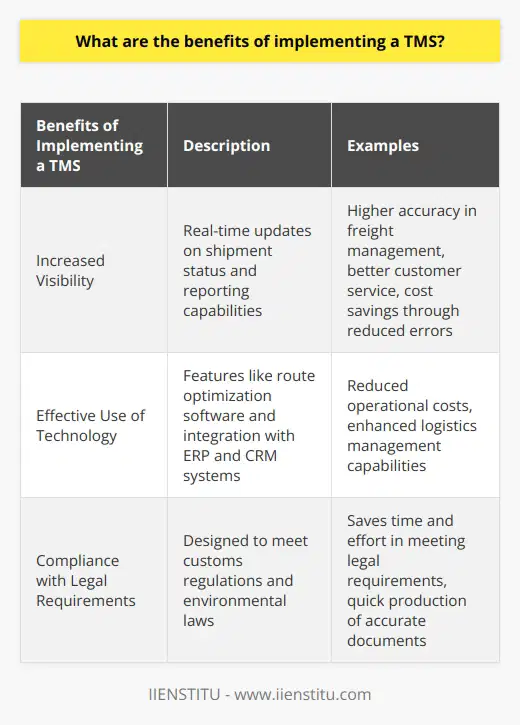
What challenges come with using a TMS?
The implementation of a Transportation Management System (TMS) can bring a great deal of value to an organization. However, it can also bring with it a variety of challenges. These challenges can range from functional complexity to data integration to cost.
Functional complexity is one of the most common challenges of using a TMS. A TMS is a complex system requiring significant integration and customization to meet the organization's needs. This requires a significant amount of time, effort, and resources. In addition, a TMS requires ongoing maintenance and support to ensure it is running effectively.
Data integration can also be a challenge when using a TMS. A TMS requires the integration of data from disparate systems, such as Enterprise Resource Planning (ERP) systems, Warehouse Management Systems (WMSs), and Customer Relationship Management (CRM) systems. This can be a time-consuming and challenging process that requires significant effort and resources.
The cost associated with implementing and maintaining a TMS can also be a challenge. Implementing a TMS requires a significant financial investment, and maintaining it requires ongoing costs. This can be a difficult hurdle for many organizations, as it requires significant resources and capital.
Overall, using a TMS can bring significant value to an organization, but it also brings various challenges. It is essential to consider these challenges when deciding whether or not to implement a TMS. With the right resources and support, these challenges can be managed to maximize a TMS's value.
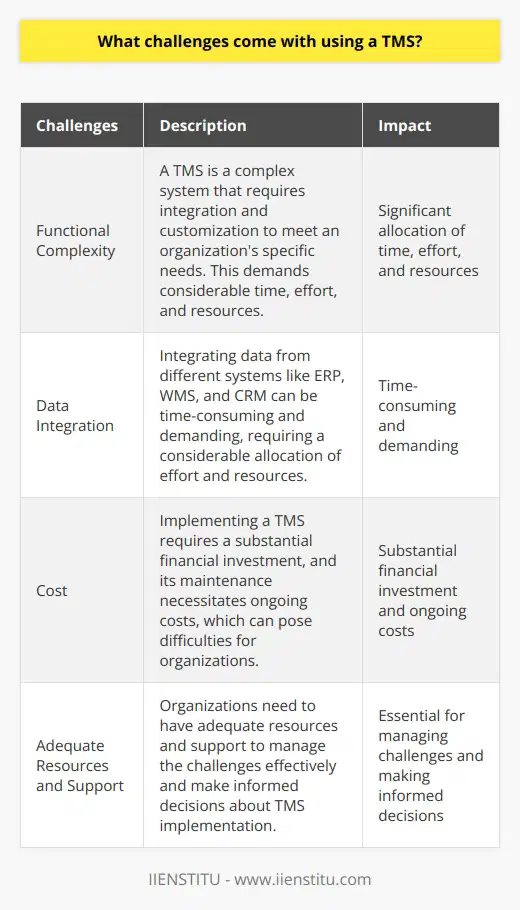
How much does it cost to implement and maintain a TMS?
When a company is looking to upgrade its logistics system, the cost of implementing and maintaining a Transportation Management System (TMS) is an essential factor that needs to be considered. Understanding the costs associated with a TMS is essential to ensure it fits within an organization's budget.
The cost of implementing and maintaining a TMS can vary depending on several factors, such as the organization's size, the complexity of the system, and any additional features or services requested. Generally speaking, companies can expect to spend anywhere from $25,000 - $500,000 for initial implementation costs. This includes software licensing fees, hardware costs, training expenses, and consulting fees. In addition to these one-time costs, ongoing maintenance fees are associated with using a TMS, ranging from 1-3% of the total annual shipping spend.
In order to determine how much it will cost to implement and maintain a TMS for your organization, it is essential to understand your specific requirements and needs. Therefore, it is recommended that you speak with potential vendors to get an accurate estimate of what you can expect regarding setup and ongoing maintenance expenses. Additionally, some vendors may offer subscription-based pricing models, which can reduce upfront costs and make budgeting easier for organizations with limited resources for implementation projects.
Overall, understanding the cost associated with implementing and maintaining a TMS is essential for companies looking for an efficient way to manage their logistics operations. By researching different vendors and getting quotes on setup fees and long-term expenses, you will be better equipped when deciding which system best fits your needs.
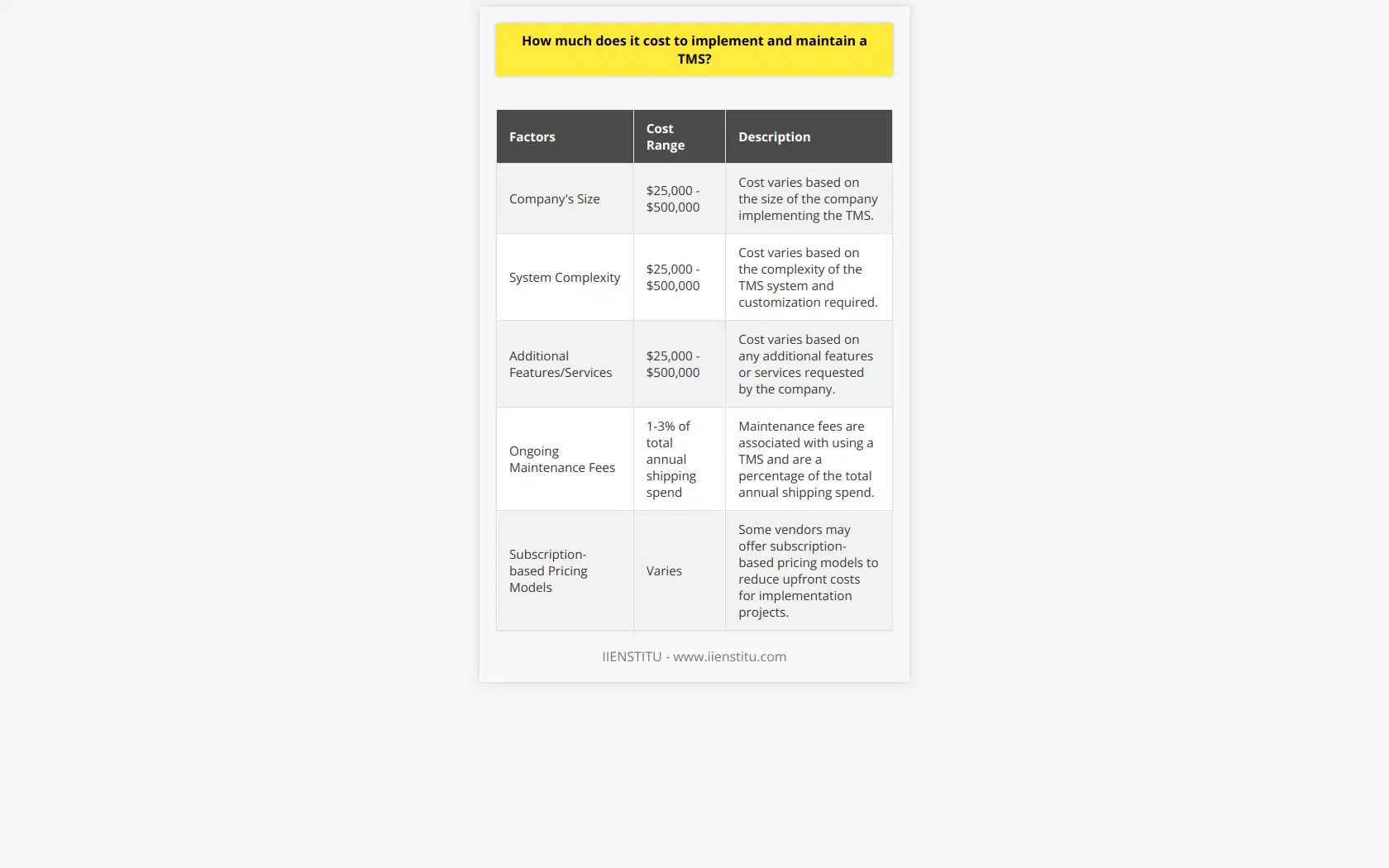
What is the role of a transportation management system (TMS) in enhancing logistics efficiency?
Role of TMS in Enhancing Logistics Efficiency
**Streamlining Operations**
A transportation management system (TMS) plays a vital role in enhancing logistics efficiency by streamlining operations, enabling companies to optimize their transportation processes. TMSs facilitate proper planning and management of resources, resulting in faster and cost-effective movement of goods.
**Optimizing Route Selection**
One of the main functionalities of a TMS is optimizing route selection. By employing advanced algorithms, TMSs help in identifying the most suitable routes, considering factors such as distance, traffic, and fuel consumption. This leads to reduced transit time and cost savings.
**Automation and Data Management**
TMSs also enhance logistics efficiency through automation and data management. Automating tasks such as shipment tracking, invoicing, and carrier selection reduces the risk of human error and increases productivity. Additionally, TMSs generate valuable data that can be analyzed to make informed decisions, contributing to overall operational efficiency.
**Real-time Visibility**
An essential aspect of efficient logistics is real-time visibility across the entire supply chain. TMSs provide constant updates on shipment status and location, ensuring timely deliveries and proactive problem-solving. This increased visibility helps organizations respond to unexpected events and maintain customer satisfaction.
**Reduced Costs**
Lastly, a TMS significantly contributes to reduced costs by optimizing carrier selection, minimizing fuel consumption, and decreasing administrative costs through automation. The cost savings obtained through these optimizations enable companies to allocate resources more effectively, resulting in higher operational efficiency.
In conclusion, a transportation management system plays a crucial role in enhancing logistics efficiency by streamlining operations, optimizing route selection, automating tasks, providing real-time visibility, and reducing costs. By adopting a TMS, companies can optimize their logistics processes and maximize their overall performance in the supply chain.
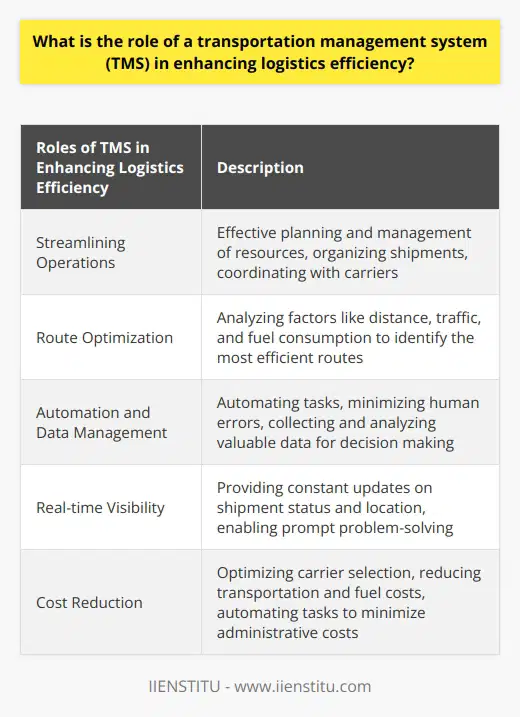
How does a TMS affect key performance indicators (KPIs) in supply chain management?
Impact on Efficiency and Accuracy
A Transportation Management System (TMS) significantly influences Key Performance Indicators (KPIs) in supply chain management by improving efficiency and accuracy. TMS automates crucial processes such as route planning, carrier selection, and documentation, reducing the time spent on manual tasks. As a result, the operation becomes more streamlined, leading to faster delivery times and reduced labor costs.
Enhanced Visibility and Monitoring
Additionally, a TMS provides increased visibility into the supply chain, enabling managers to monitor KPIs in real-time. They can analyze data related to carrier performance, transportation costs, and delivery times, allowing them to make informed decisions and address potential issues before they escalate. This enhanced transparency promotes proactive management, improving the overall performance of the supply chain.
Reduced Costs
TMS implementation also contributes to cost reduction, a crucial KPI in the supply chain. The system enables shippers to negotiate better rates with carriers and ensures the most cost-effective routes are used for transportation. Furthermore, a TMS reduces the need for expedited shipments, saving money on expensive last-minute deliveries.
Improved Customer Satisfaction
Customer satisfaction is another KPI that benefits from a TMS. The data-driven approach ensures optimal route planning, leading to reduced delivery times and fewer delays. With accurate tracking systems in place, customers can be kept informed about their shipments' progress, improving the overall customer experience.
Enhanced Sustainability
The adoption of a TMS also supports environmental sustainability efforts by minimizing fuel consumption and emissions. The system identifies the most efficient routes and consolidates shipments where possible, reducing the overall carbon footprint of the supply chain operations. This not only benefits the environment but can also improve a company's brand image in a growing eco-conscious market.
In conclusion, a TMS plays a pivotal role in enhancing various KPIs in supply chain management by promoting efficiency, accuracy, visibility, cost reduction, customer satisfaction, and sustainability. The implementation of a TMS enables organizations to optimize their supply chain operations, leading to increased competitiveness and long-term success.
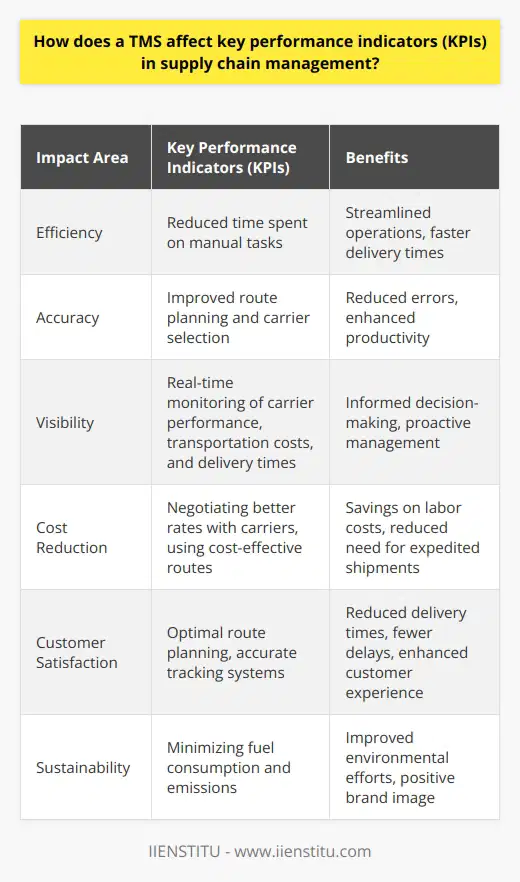
What factors should be considered when selecting a TMS for a logistics operation?
Functional Requirements
When selecting a TMS (Transportation Management System) for a logistics operation, one must consider functional requirements, which include the capabilities to plan, execute, and monitor transportation activities. This ensures that the TMS addresses the organization's needs at an operational level and streamlines the flow of goods and services while reducing costs.
Integration and Scalability
Another essential factor is the TMS's integration capabilities with other tools and systems, such as warehouse management systems, enterprise resource planning solutions, and carrier systems. This integration ensures seamless communication among different platforms, improving efficiency and data quality in the logistics operation. Furthermore, the TMS must be scalable, allowing businesses to adapt quickly to changes in volume, customers, or markets.
Cost-effectiveness and ROI
Cost-effectiveness should also be considered, as the benefits of the TMS must outweigh the costs incurred during its implementation and maintenance. Evaluating the return on investment (ROI) of a TMS involves analyzing the potential savings and operational improvements it can bring to a logistics operation. Factors such as reduced freight charges, increased transportation efficiency, and improved customer satisfaction contribute to the overall ROI.
Vendor Support and Training
Effective vendor support is crucial when selecting a TMS. Organizations should evaluate the vendor's ability to provide training to users, ensuring they can effectively utilize the system. Additionally, ongoing technical support must be available to address any issues that may arise during the TMS's operation. A reliable vendor that offers comprehensive support will improve the likelihood of a successful TMS implementation.
Security and Compliance
Finally, security and compliance are critical factors in the selection of a TMS. The system must protect sensitive data, such as customer or financial information, from potential malicious attacks or unauthorized access. Additionally, the TMS should comply with relevant regulations and industry standards to ensure its legitimacy and the organization's adherence to legal requirements.
In conclusion, selecting a TMS for a logistics operation requires evaluating multiple factors, such as functional requirements, integration capabilities, cost-effectiveness, vendor support, and security. By carefully considering these factors, organizations can find a TMS that best meets their specific needs and enhances their logistics operations.
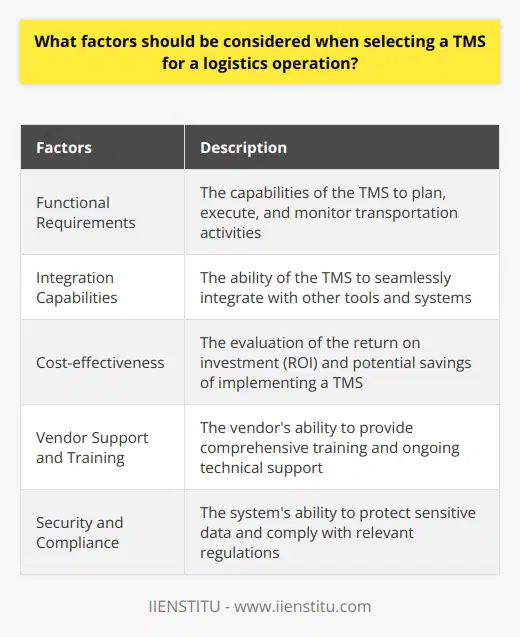
What is the impact of adopting a TMS on the overall sustainability and environmental footprint of logistics operations?
Enhancing Sustainability with TMS
The deployment of a Transportation Management System (TMS) plays an influential role in enhancing the ecological footprint of logistics operations. A TMS optimizes delivery routes, which results in reduced greenhouse gas emissions from vehicle fuels.
Furthermore, it enables more efficient use of vehicle capacity. This lessens the need for multiple trips, saving energy. A streamlined process directly contributes to an organization's sustainability goals.
Advancing Fuel Efficiency
When logistics companies can plan more precise routes with TMS, it mitigates fuel consumption drastically. Likewise, idle time, a major source of wasted energy and unnecessary emissions, is also minimized. By curtailing this, companies contribute substantively to having a smaller environmental footprint.
Reducing Paper Waste
The adoption of a TMS also impacts the extent of paper waste produced by logistics operations. An electronically managed system mitigates the need for paper documentation. The system harbors digital alternatives, like electronic invoices, that are more environmentally friendly.
Improving Carbon Footprint Tracking
TMS aids in the accurate tracking of the logistics operation's carbon footprint. With detailed and accurate data, companies can ideate and implement effective strategies to reduce their emissions.
In conclusion, the implementation of a TMS genuinely mitigates the environmental damage logistics operations may incur. Thus, propelling the sustainability initiatives of these companies, reducing waste production, and proactively contributing to the conservation of our environment.
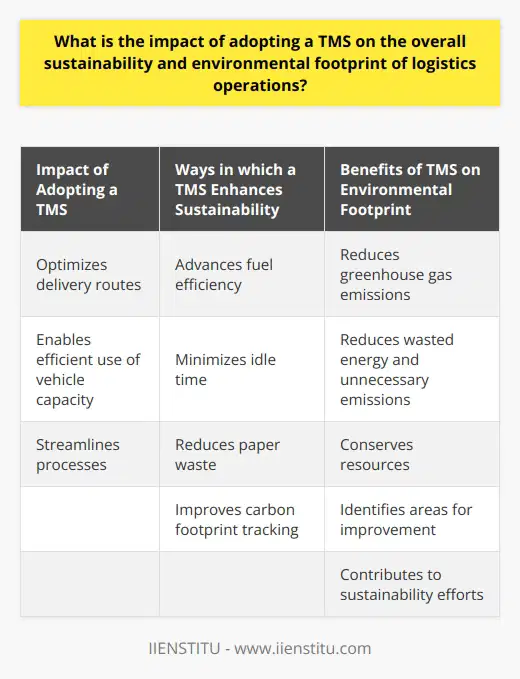
How does the integration of a TMS with other supply chain management technologies enhance visibility, collaboration, and decision-making in logistics?
Enhanced Visibility through TMS Integration
The integration of a Transportation Management System (TMS) with other Supply Chain Management (SCM) technologies offers enhanced visibility. This visibility extends across all logistics operations. It aids in tracking the movement of goods from the point of origin to the final destination. By connecting various SCM technologies, a comprehensive view of the entire supply chain emerges.
Promoted Collaboration through TMS Integration
Moreover, the integration of TMS with other SCM technologies fosters collaboration. It allows different parties in the supply chain to share relevant data. Suppliers, manufacturers, and retailers, for example, can access updated data. This sharing culture optimizes operations and reduces inefficiencies.
Improved Decision-making through TMS Integration
Furthermore, TMS integration with other SCM technologies improves decision-making in logistics. The availability of real-time data aids logistics managers in making informed decisions. They can respond quickly to changes, manage risks, and optimize resources effectively.
In conclusion, integrating a TMS with other SCM technologies helps organizations attain a higher level of visibility, collaboration, and decision-making in logistics. This integration yields significant benefits, contributing to operational efficiency and profitability. The real-time data provided by this integration serves as a vital tool for strategic decision-making in supply chain management.
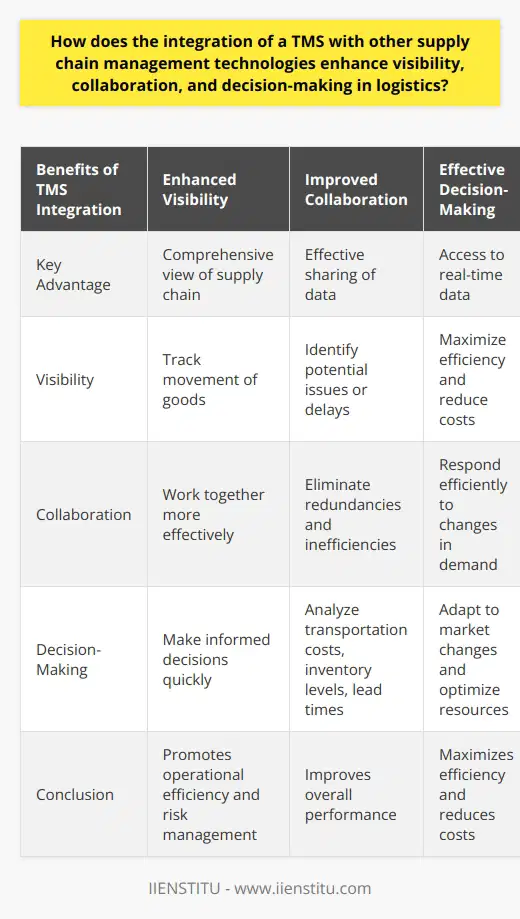
How do transportation management systems support risk management and mitigation strategies in logistics networks?
Risk Mitigation Strategies Enabled by Transportation Management Systems
Transportation management systems (TMS) play an integral role in supporting risk management within logistics networks. They lend a significant hand in mitigating potential risks through advanced technologies and systematic approaches.
Risk Identification and Analysis
Firstly, TMS aids in identifying and analyzing potential risks by collating and analyzing data. This system swiftly identifies potential discrepancies and imbalances within logistics operations, thereby foreseeing potential risks and obstacles.
Real-time Monitoring
TMS can enable real-time monitoring of cargo movements. Through GPS tracking and real-time updates, threats of theft, loss, or delay become manageable, reducing potential risks considerably.
Route Optimization
TMS also provides solutions for route optimization, steering clear of perilous regions or those with heavy traffic. Efficient route planning considerably reduces the risk of delays, enhancing timely delivery and client satisfaction.
Disaster Recovery and Contingency Planning
TMS also helps in disaster recovery and contingency planning. If a natural disaster or unforeseen event disrupts a route, the system swiftly maps out alternate routes, ensuring minimal impacts on plans.
Preventing Overloading and Underloading
The use of TMS helps avoid overloading and underloading situations. Precise cargo measurement prevents overloading which can lead to significant road accidents. At the same time, it avoids underloading, maximizing cargo space usage without risking safety.
In conclusion, TMS provides the infrastructure necessary to mitigate a broad spectrum of risks in logistics networks. It enables swift identification, response, and prevention of potential issues. These potentials make TMS integral in building resilient, efficient, and safe logistics networks. Thus, leveraging TMS in risk management is imperative for the smooth operation of logistics networks.
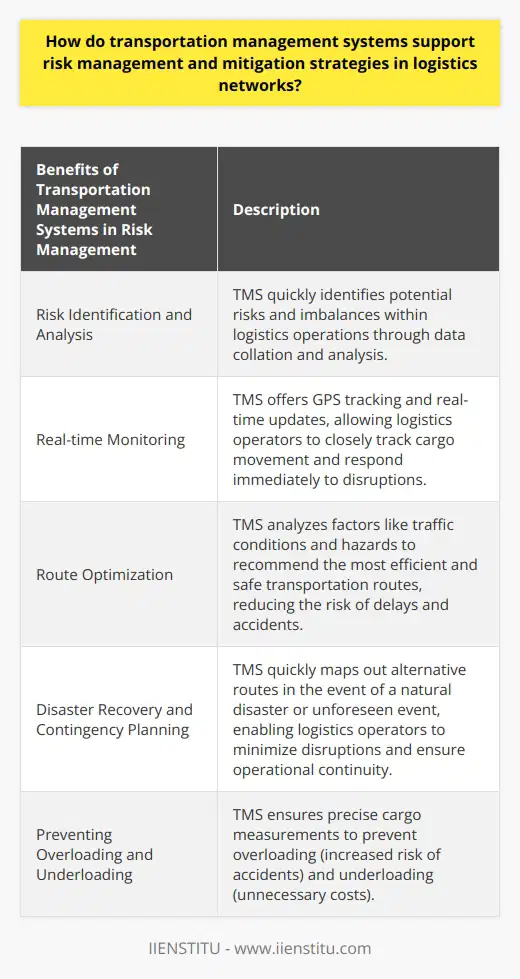
What is TMS in logistics?
Understanding TMS in Logistics
TMS refers to Transportation Management System in logistics. It is a software suite designed to manage transportation operations. This system empowers logistics providers to streamline their processes.
Key Features of TMS
A TMS typically contains features for planning, executing, and optimizing the shipment of goods. Users can manage and coordinate their inventory with the help of a TMS. It also assists in initiating and tracking shipments in real-time.
Importance of TMS
The utilization of a TMS plays a crucial role in reducing shipping errors. It improves efficiency, accuracy, and profitability in freight and logistics operations. Further, digital TMS helps reduce paperwork, manual tasks and increases customer satisfaction.
TMS and Digital Advancements
Modern TMS has embraced technological advancements such as Artificial Intelligence and Machine Learning. These features automate processes and increase the accuracy of data analysis. Eventually, they improve decision-making processes in logistics operations.
TMS Role in Cost Reduction
A TMS can notably reduce costs. This is possible by optimizing route plans and aiding efficient fuel usage. As a result, it provides an economical solution for managing logistics.
In conclusion, TMS plays an integral part in modern logistics. Its functionality and benefits are essential in maintaining an efficient and cost-effective logistics operation. With the rapid digital advancements, TMS continues to evolve, offering a comprehensive solution to manage transportation operations.
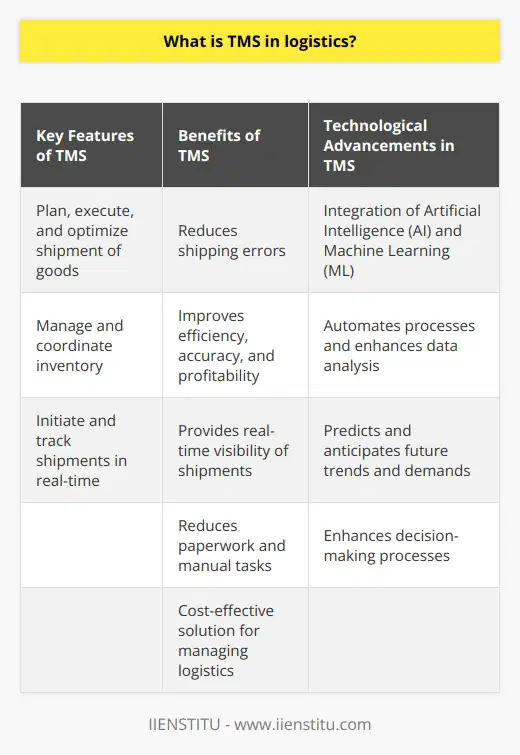
How important is a TMS (transportation management system) in logistics operations?
Significance of TMS in Streamlining Operations
A Transportation Management System (TMS) stands as a pivotal tool in contemporary logistics operations. It offers unprecedented precision and efficiency, ensuring smooth and cost-effective supply chains.
TMS and Operational Efficiency
One fundamental aspect of TMS is its ability to boost operational efficiency. It meticulously manages and consolidates shipments, thereby minimizing unnecessary trips. It helps optimize freight loads, allocate resources aptly, and reduces fuel consumption. This results in substantial cost savings.
Role in Decision Making
A TMS also plays a vital role in informed decision-making. By providing real-time tracking and analytical insights into logistical processes, it allows businesses to identify bottlenecks, conduct performance evaluations, and strategize improvements.
TMS in Enhancing Customer Relations
Moreover, TMS significantly enhances customer relations. By facilitating timely and accurate deliveries, it fosters customer trust and satisfaction. Its tracking features empower the customer with an instantaneous overview of their shipment status, thereby providing an improved service experience.
TMS for Eco-friendly Operations
Furthermore, a TMS inherently supports environmentally responsible operations. By enabling route optimization and reducing idle time, it minimises CO2 emissions. Thus, businesses using TMS inherently contribute to sustainable practices.
To conclude, the importance of a TMS in logistics operations is unequivocal. It unlocks greater efficiency, better insights for decision-making, enhanced customer relations, and supports environmentally sustainable practices. Therefore, the inclusion of a TMS should be an integral part of any organization aiming for excellence in logistics operations.
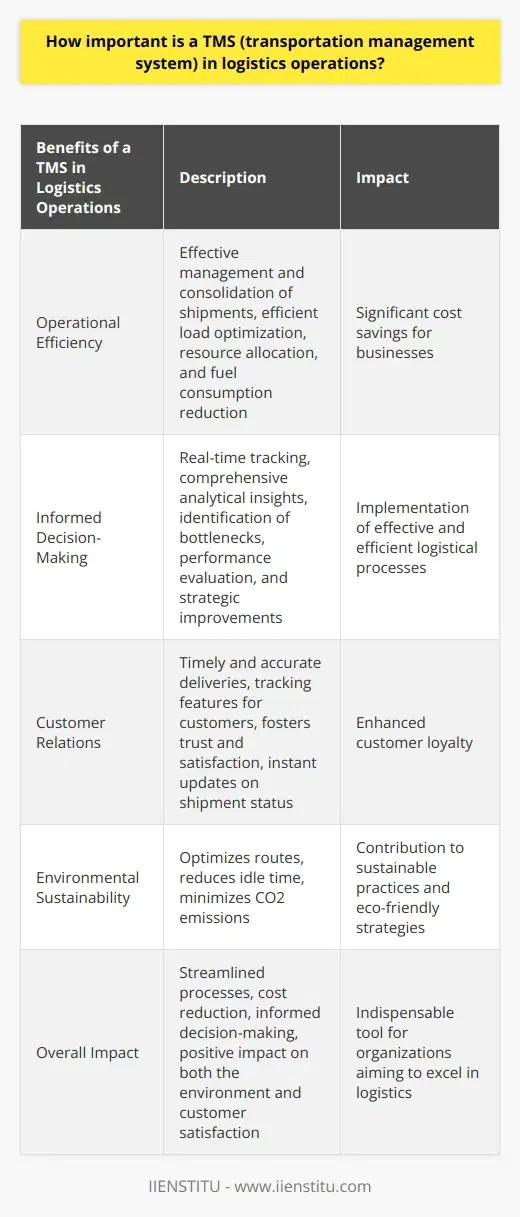
How can a transportation management system (TMS) help to improve the logistics network?
Enhancing Efficiency through TMS
A Transportation Management System (TMS) significantly improves the logistics network. Firstly, it optimizes freight management. It reduces costs through centralized freight data tracking, efficient route planning, and maintaining good relationships with carriers.
Decrease in Time and Costs
TMS employs algorithms to select the most cost-effective transportation method, thus saving businesses money. For example, instead of batching shipments, a TMS analyses prices for all shipping methods and pickup timings, then it provides the most sustainable and cost-effective option. This leads to significant time savings, reducing manual work and promoting productivity.
Improvement of Customer Service
Customer service standards see improvements through their TMS. The system provides real-time tracking, thereby increasing transparency and communication between customer and business. This leads to increased satisfaction and trust among customers, which in turn amplifies loyalty and profitability.
Inventory Management
Furthermore, a well-implemented TMS helps in inventory management. It monitors stock levels and provides alerts when restocking is due, thus preventing stock-outs and overstocking.
Enhanced Decision-Making
Finally, a TMS improves decision-making by providing analytics and reports. It offers insights into freight costs and trends, allowing businesses to make data-driven decisions. These improvements from a TMS contribute to the efficiency and effectiveness of logistics networks.
